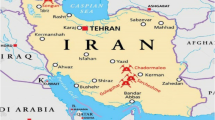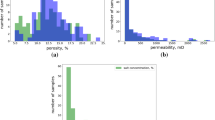Abstract
Geospatial technology is increasing in demand for many applications in geosciences. Spatial variability of the bed/hard rock is vital for many applications in geotechnical and earthquake engineering problems such as design of deep foundations, site amplification, ground response studies, liquefaction, microzonation etc. In this paper, reduced level of rock at Bangalore, India is arrived from the 652 boreholes data in the area covering 220 km2. In the context of prediction of reduced level of rock in the subsurface of Bangalore and to study the spatial variability of the rock depth, Geostatistical model based on Ordinary Kriging technique, Artificial Neural Network (ANN) and Support Vector Machine (SVM) models have been developed. In Ordinary Kriging, the knowledge of the semi-variogram of the reduced level of rock from 652 points in Bangalore is used to predict the reduced level of rock at any point in the subsurface of the Bangalore, where field measurements are not available. A new type of cross-validation analysis developed proves the robustness of the Ordinary Kriging model. ANN model based on multi layer perceptrons (MLPs) that are trained with Levenberg–Marquardt backpropagation algorithm has been adopted to train the model with 90% of the data available. The SVM is a novel type of learning machine based on statistical learning theory, uses regression technique by introducing loss function has been used to predict the reduced level of rock from a large set of data. In this study, a comparative study of three numerical models to predict reduced level of rock has been presented and discussed.























Similar content being viewed by others
Abbreviations
- a:
-
Range of the variogram
- b:
-
The scalar threshold
- C:
-
Capacity factor (for learning machine)
- C (0) :
-
σ Sill of the variogram
- C0 :
-
Nugget of the variogram
- l:
-
The number of training sets
- Rn :
-
n-Dimensional real vector space
- w:
-
The boundary
- wi :
-
Weight assigned to each scater point
- x:
-
The input vector
- y:
-
A binary value representing the two classes
- δk :
-
Actual error
- ε:
-
Error insensitive zone
- εk :
-
Normalized error
- ρ(w,b):
-
Margin
- γ (h):
-
Semi-variogram
- σ:
-
The width of radial basis function
- Γ:
-
Gamma function
References
Aleksandar I, Morton H (1990) An introduction to neural computing. Chapman and Hall, London
Boser BE, Guyon IM, Vapnik VN (1992) A training algorithm for optimal margin classifiers. In: Haussler D (ed) 5th Annual ACM workshop on COLT. ACM Press, Pittsburgh, pp 144–152
Burgress TM, Webster R (1980a) Optimal interpolation and isarithmic mapping of soil properties I. The semivariogram and punctual kriging. J Soil Sci 31:315–331
Burgress TM, Webster R (1980b) Optimal interpolation and isarithmic mapping of soil properties II. Block kriging. J Soil Sci 31:333–341
Clark I (1979) Practical geostatistics. Applied Science Publishers, Ltd., London, 129 pp
Davis JC (2002) Statistics and data analysis in geology, 3rd edn. Wiley, New York
Demuth HB, Beale M (1999) Neural Network Toolbox, users guide. The Mathworks, Inc., Natick
Dibike YB, Velickov S, Solomatine D, Abbot MB (2001) Model induction with support vector machine: introduction and application. J Comput Civil Eng 15(3):208–216
Dowla FU, Rogers LL (1995) Solving problems in environmental engineering and geoscience with artificial neural networks. MIT, Cambridge
Drucker H, Donghui W, Vapnik VN (1999) Support vector machine form spam categorization. IEEE Trans Neural Netw 10(5):1048–1054
Foody GM, Mathur A (2004) A relative evaluation of multiclass image classification by support vector machines. IEEE Trans Geosci Remote Sens 42(6):1335–1343
Furey TS, Cristianini N, Duffy N, Bednarski DW Bednarski, Schummer M Haussler D (2000) Support vector machine classification and validation using microarray expression data. Bioinformatics 16(10):906–914
Guillaume A (1977) Introduction a la géologie quantitative: Masson, Paris
Gunn S (1998) Support vector machines for classification and regression. Image Speech and Intelligent Systems Technical Report, University of Southampton, UK
Gunn R (2003) Support vector machines for classification and regression. http://www.ecs.soton.ac.uk/∼srg/publications/pdf/SVM.pdf
Guyon I, Weston J, Steohen B, Vapnik V (2002) Gene selection for cancer classification using support vector machines. Mach Learn 46(1–3):389–422
Hagan MT, Menhaj MB (1994) Training feedforward networks with the Marquardt algorithm. IEEE Trans Neural Netw 5(6):989–993
Hagan MT, Demuth HB, Beale M (1996) Neural network design. PWS, Boston
Haykin S (1999) Neural networks: a comprehensive foundation. Prentice-Hall Inc., New Jersey
Hebb DO (1949) The organization of behavior. Wiley, New York
Hertz J, Krogh A, Palmer R (1991) Introduction to the theory of neural computation. Addison-Wesly, Reading
Isaaks EH, Srivastava RM (1989) An introduction to applied geostatics. Oxford University Press, New York
Journel AG, Huijbregts CJ (1978) Mining geostatistics. Academic Press, New York
Khanna T (1989) Foundations of neural networks. Addison-Wesly, Reading
Kitanidis PK (1991) Orthonormal residuals in geostatistics: model criticism and parameter estimation. Math Geol 23(5):741–758
Kitanidis PK (1997) Introduction to geostatistics: applications in hydrogeology. Cambridge University Press, pp 86–95
Kohonen T (1988) An introduction to neural computing. Neural Netw 1(1):3–16
Matheron G (1963) Principles of geostatistics. Econ Geol 58:1246–1266
Matheron G (1972) Théorie des variables régionalisées in Traité d’Informatique Géologique. Masson, Paris, pp 306–378
MathWork, Inc. (1999) Matlab user’s manual, version 5.3. The MathWorks, Inc., Natick
McCulloch WS, Pitts W (1943) A logical calculus in the ideas immanent in nervous activity. Bull Math Biophys 5:115–133
More JJ (1977) The Levenberg-Marquardt algorithm: implementation and theory. In: Watson GA (ed) Numerical analysis. Springer, Heidelberg, pp 105–116
Mukherjee S, Osuna E, Girosi F (1997) Nonlinear prediction of chaotic time series using support vector machine. In: Proceedings of the IEEE workshop on neural networks for signal processing 7. Institute of Electrical and Electronics Engineers, New York, pp 511–519
Muller KR, Smola A, Ratsch G, Scholkopf B, Kohlmorgen J, Vapnik V (1997) Predicting time series with support vector machines. In: Proceedings of the international conference on artificial neural networks. Springer-Verlag, Berlin, 999
Osuna E, Freund R, Girosi F (1997) An improved training algorithm for support vector machines. In: Proceedings of the IEEE workshop on neural networks for signal processing 7. Institute of Electrical and Electronics Engineers, New York, pp 276–285
Radhakrishna BP, Vaidyanadhan R (1997) Geology of Karnataka. Geological Society of India, Bangalore
Rendu JM (1978) An introduction to geostatistical methods of mineral evaluation. S African Inst of Min and Metal, Kimberly, 84 pp
Rosenblatt F (1958) The perceptron: a probabilistic model for information storage and organization in the brain. Psychol Rev 68:386–408
Rubeis VD, Tosi P, Gasparini C, Solipaca A (2005) Application of Kriging technique to seismic intensity data. Bull Seismol Soc Am 95(2):540–548
Shahin MA, Jaksa MB, Maier HR (2000) Predicting the settlement of shallow foundations on cohesion less soils using back-propagation neural networks. Department of Civil and Envi Eng, University of Adelaide, Australia, R167
Sincero AP (2003) Predicting mixing power using artificial neural network. EWRI World Water and Environmental
Smola A (1996) Regression estimation with support vector learning machines. Technische Universitat Munchen, Munchen
Vapnik V (1995) The nature of statistical learning theory. Springer, New York
Vapnik V, Golowich S, Smola A (1997) Support method for function approximation regression estimation and signal processing. In: Mozer M, Petsch T (eds) Advance in neural information processing system 9. MIT Press, Cambridge
Acknowledgements
Authors thank Seismology division, Department of Science and Technology, Government of India for funding the project titled “Geotechnical site characterization of greater Bangalore region”. Ref no. DST/23(315)/SU/2001 dated October 2003.
Author information
Authors and Affiliations
Corresponding author
Rights and permissions
About this article
Cite this article
Sitharam, T.G., Samui, P. & Anbazhagan, P. Spatial Variability of Rock Depth in Bangalore Using Geostatistical, Neural Network and Support Vector Machine Models. Geotech Geol Eng 26, 503–517 (2008). https://doi.org/10.1007/s10706-008-9185-4
Received:
Accepted:
Published:
Issue Date:
DOI: https://doi.org/10.1007/s10706-008-9185-4




